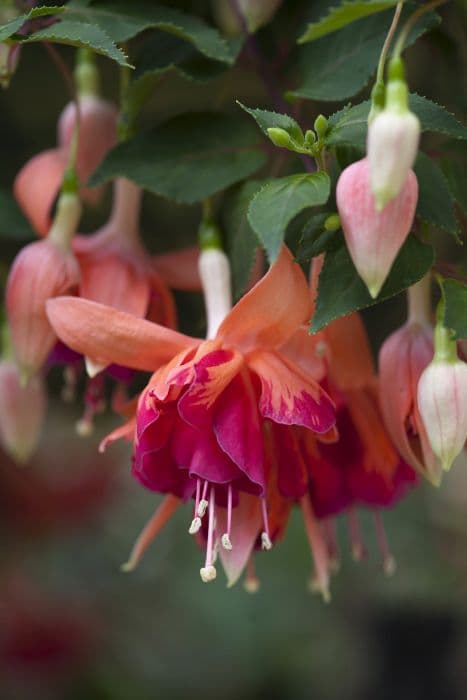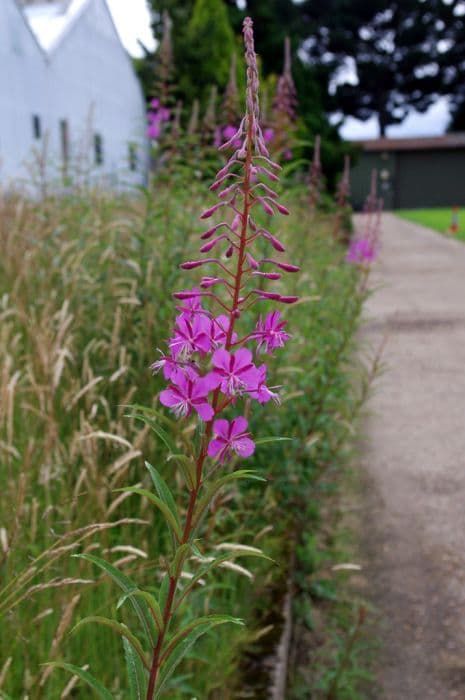Fuchsia Fuchsia 'Orange King' (d)

ABOUT
The Fuchsia 'Orange King' is a captivating ornamental plant known for its unique and vibrant flowers. Its blooms are particularly eye-catching, with a combination of fiery shades, as the name suggests. The flowers have an elegant, teardrop shape that dangles gracefully from the stems, giving the plant a delicate, almost whimsical appearance. Each blossom is comprised of a vivid outer layer, which can have a striking hue reminiscent of burnt orange or a deep coral. Contrasting this outer color is the inner layer of petals, which often presents in a softer, slightly paler shade, creating an enchanting two-tone effect. The petals are surrounded by long, slender sepals that can be a deeper orange or sometimes have a pink or reddish tinge, further adding to the complexity and depth of the flower's visual appeal. This flamboyant display is complemented by a backdrop of lush green foliage. The leaves are typically oval-shaped with a slight point at the tip and have a smooth or slightly serrated edge. The foliage's deep green color serves as a rich canvas that accentuates the brightness of the blooms. In addition to its striking flowers, the Fuchsia 'Orange King' possesses a gently arching growth habit, with branches that tend to cascade or hang. This makes it a popular choice for gardeners looking to add a splash of color to hanging baskets, containers, or as a feature in a mixed border where its overhanging blooms can be truly appreciated. The contrast between the bold flowers and the dark green leaves, combined with its graceful form, makes the Fuchsia 'Orange King' a dazzling presence in any garden setting.
About this plant
 Names
NamesFamily
Onagraceae
Synonyms
Orange King Fuchsia, Orange King Hummingbird Fuchsia, Orange King Lady's Eardrops, Orange King Fairy's Thimble
Common names
Fuchsia 'Orange King'
 Toxicity
ToxicityTo humans
Fuchsia is generally considered non-toxic to humans. However, as with any plant, individual sensitivities can vary, and ingesting parts of the plant could potentially result in mild gastrointestinal discomfort.
To pets
Fuchsia is also generally considered non-toxic to pets. Ingesting parts of the plant might occasionally cause mild gastrointestinal upset, but serious toxicity is not expected. However, pet owners should always monitor their animals for any adverse reactions after ingestion of plant material.
 Characteristics
CharacteristicsLife cycle
Perennials
Foliage type
Deciduous
Color of leaves
Green
Flower color
Orange
Height
2 feet (0.61 meters)
Spread
2 feet (0.61 meters)
Plant type
Shrub
Hardiness zones
9
Native area
Central America
Benefits
 General Benefits
General Benefits- Attractive Flowers: Produces vibrant orange-red flowers that are visually striking and can add a pop of color to any garden.
- Hummingbird Attractor: The Fuchsia plant is known to attract hummingbirds, which can add an element of wildlife to the garden.
- Shade Tolerant: Fuchsia 'Orange King' can thrive in partial shade, making it a flexible choice for various garden lighting conditions.
- Long Blooming Season: Offers a lengthy blooming period that extends from spring through fall, providing long-lasting garden interest.
- Container Gardening: Suitable for pots and hanging baskets, allowing for versatility in garden design and decoration of patios or balconies.
- Easy Pruning: Responds well to pruning, making it easy to maintain a desirable shape and size.
- Combination Planting: Pairs well with other shade-loving plants, which enables the creation of diverse and attractive garden arrangements.
 Medical Properties
Medical PropertiesThis plant is not used for medical purposes.
 Air-purifying Qualities
Air-purifying QualitiesThis plant is not specifically known for air purifying qualities.
 Other Uses
Other Uses- Fuchsia 'Orange King' can be used as a natural dye, providing fabrics with soft purple or pink hues depending on the mordant used.
- The slightly tart berries of the Fuchsia 'Orange King' can be made into a unique, tangy jelly or jam for culinary use.
- Fuchsia plants can be a teaching tool for botany enthusiasts, demonstrating how to care for and propagate semi-tender perennials.
- Incorporating Fuchsia 'Orange King' in a sensory garden provides a tactile experience with its soft flowers and textured foliage.
- This plant can be used in hanging baskets to create living curtains that offer privacy on porches or patios.
- Fuchsia flowers can be candied and used as edible decorations for desserts and pastries, adding both color and a touch of elegance.
- 'Orange King' can be part of a butterfly garden, as its vivid flowers are attractive to butterflies and hummingbirds.
- The plant can serve as a natural indicator for over-fertilization in gardens, as its leaves may yellow in response.
- Fuchsia 'Orange King' can be shaped and used in topiary art, creating ornamental shapes for garden design.
- The drooping flowers can be used as natural ornaments on gift packages or in crafting, adding a unique, organic embellishment.
Interesting Facts
 Feng Shui
Feng ShuiThe Fuchsia plant is not used in Feng Shui practice.
 Zodiac Sign Compitability
Zodiac Sign CompitabilityThe Fuchsia plant is not used in astrology practice.
 Plant Symbolism
Plant Symbolism- Elegance: Fuchsia 'Orange King' with its graceful, drooping flowers epitomizes elegance in the plant kingdom, often symbolizing good taste and sophistication.
- Vibrancy: The vivid orange-red color of the 'Orange King' blooms represents energy, enthusiasm, and vitality, reflecting a vibrant spirit or lifestyle.
- Individuality: Since fuchsias, in general, come in an array of unique shapes and colors, they often stand for personal uniqueness and the celebration of differences.
- Confiding love: In the language of flowers, fuchsias have been gifted to convey trust and confiding love, possibly due to the intimate way the petals enfold upon themselves.
- Overflowing abundance: Given their prolific blooming nature, fuchsias may symbolize abundance or overflowing generosity, mirroring the copious flow of their blossoms.
- Gracious hospitality: With their inviting appearance, fuchsias are sometimes seen as a symbol of welcoming and hospitality, hence the 'Orange King' could represent a warm and open-hearted host.
 Water
WaterFuchsia 'Orange King', commonly known as hardy fuchsia, should be watered deeply and thoroughly, allowing the water to reach the roots without sogging the soil. In general, watering once a week with about one gallon per plant should suffice, but this can vary depending on the climate and weather conditions. During hot, dry periods, you may need to water more frequently, while in cooler, rainy conditions, you can water less often. Always check the top inch of soil for dryness before watering—hardy fuchsia prefers consistently moist soil, but not waterlogged.
 Light
LightHardy fuchsia thrives best in partial shade to dappled sunlight. It should be protected from the hot afternoon sun, which can scorch its leaves. A spot that receives morning sunlight and is shaded in the afternoon is ideal for this plant. Even in cooler climates, diffuse light is preferred over direct, harsh sun exposure.
 Temperature
TemperatureHardy fuchsia does well in a range of temperatures but prefers mild conditions. It can usually tolerate minimum temperatures down to about 40 degrees Fahrenheit, but it thrives in the range of 60 to 75 degrees Fahrenheit. This plant may struggle if exposed to temperatures above 85 degrees Fahrenheit, so it should be protected from extreme heat.
 Pruning
PruningPruning hardy fuchsia is important to encourage bushy growth and ample flowering. It should be pruned in late winter or early spring before new growth starts. Remove any dead or broken branches and cut back up to one-third of the plant to promote new shoots. Additionally, deadheading the spent flowers throughout the growing season will help promote more blooms.
 Cleaning
CleaningAs needed
 Soil
SoilThe Fuchsia 'Orange King', commonly known as Orange King Fuchsia, thrives best in a well-draining, fertile potting mix with added peat and perlite. Aim for a soil pH between 6.0 and 7.0 for optimal growth.
 Repotting
RepottingOrange King Fuchsia should ideally be repotted every two to three years or when it becomes root-bound to encourage healthy growth and bloom cycles.
 Humidity & Misting
Humidity & MistingOrange King Fuchsia prefers high humidity levels, generally between 60% to 70%, to flourish and produce its best blooms.
 Suitable locations
Suitable locationsIndoor
Place in bright, indirect light and maintain high humidity.
Outdoor
Shelter from wind, partial shade, ensure rich moist soil.
Hardiness zone
10-11 USDA
 Life cycle
Life cycleThe life cycle of the Fuchsia 'Orange King' begins with seed germination, where the seed requires a warm, moist environment to sprout. Upon emergence, the seedling grows and develops into a young plant, with characteristic fuchsia leaves and stems. As the plant matures, it enters the vegetative stage, growing foliage more vigorously and becoming bushy in appearance. This stage is followed by the flowering phase, where distinctive hanging flowers with orange red corollas and purple corona typically appear in warmer months, attracting pollinators. After pollination, the plant produces small fruit that contains seeds, which when mature, can be dispersed to start new plants. Throughout its life, with proper care, Fuchsia 'Orange King' may enter a period of dormancy in colder months, only to regrow and repeat the cycle in the following growing season.
 Propogation
PropogationPropogation time
Spring-Early Summer
The most popular method of propagating Fuchsia 'Orange King', commonly known as Orange King Fuchsia, is through stem cuttings. This is typically done in late spring to early summer when the plant is actively growing. To propagate, a healthy, non-flowering shoot about 2 to 4 inches long (5-10 cm) is cut just below a leaf node. The lower leaves are removed, and the cut end is dipped into a rooting hormone to encourage root development. The prepared cutting is then inserted into a pot filled with a moistened mix of peat and perlite or a similar rooting medium. Covering the pot with a plastic bag or placing it in a propagator can help maintain high humidity, a key factor for successful rooting. Roots should form within a few weeks, after which the new clone can gradually acclimate to less humid conditions before being transplanted.









